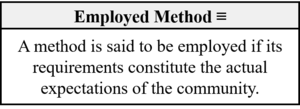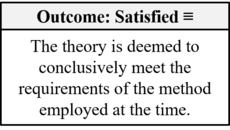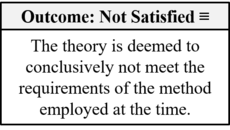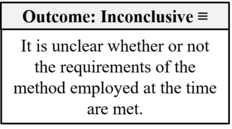Modification:Sciento-2017-0004
Accept the reformulation of the second law which explicitly links theory assessment outcomes with theory acceptance/unacceptance. To that end, accept three new definitions for theory assessment outcomes (satisfied, not satisfied, and inconclusive) as well as the new ontology of theory assessment outcomes, and accept the new definition of employed method.
The modification was suggested to Scientonomy community by Nicholas Overgaard, Hakob Barseghyan and Paul Patton on 5 February 2017.1 The modification was accepted on 29 November 2017.
Contents
Preamble
The initial formulation of the second law is flawed since it does not specify the causal relations between the outcomes of theory assessment and the actual acceptance/unacceptance of a theory; it merely tells us that a theory was assessed by the method employed at the time. This is problematic as it doesn't say what happens to a theory when a certain assessment outcome obtains. Moreover, the deductions of several theorems assume a more specific formulation of the law, in which causal connections between assessment outcomes and theory acceptance/unacceptance are clearly stated.1pp. 30-32 In particular, the deductions of the necessary and possible mosaic split theorems assume that the second law provides a clear account of the conditions under which theories become accepted or remain unaccepted.2pp. 202-208 Thus, a new formulation of the second law is needed that says how specific outcomes of theory assessment determine theory acceptance or unacceptance.
Modification
Theories To Accept
- The Second Law (Patton-Overgaard-Barseghyan-2017): If a theory satisfies the acceptance criteria of the method employed at the time, it becomes accepted into the mosaic; if it does not, it remains unaccepted; if assessment is inconclusive, the theory can be accepted or not accepted.
- Employed Method (Patton-Overgaard-Barseghyan-2017): A method is said to be employed if its requirements constitute the actual expectations of the community.
- Outcome Satisfied (Patton-Overgaard-Barseghyan-2017): The theory is deemed to conclusively meet the requirements of the method employed at the time.
- Outcome Not Satisfied (Patton-Overgaard-Barseghyan-2017): The theory is deemed to conclusively not meet the requirements of the method employed at the time.
- Outcome Inconclusive (Patton-Overgaard-Barseghyan-2017): It is unclear whether or not the requirements of the method employed at the time are met.
- Theory Assessment Outcomes (Patton-Overgaard-Barseghyan-2017): The possible outcomes of theory assessment are satisfied, not satisfied, and inconclusive.
Theories To Reject
- The Second Law (Barseghyan-2015): In order to become accepted into the mosaic, a theory is assessed by the method actually employed at the time.
- Employed Method (Barseghyan-2015): A method is said to be employed at time t if, at time t, theories become accepted only when their acceptance is permitted by the method.
- Theory Assessment Outcomes (Barseghyan-2015): The possible outcomes of theory assessment are accept, not accept, and inconclusive.
- Outcome Accept (Barseghyan-2015): An outcome of theory assessment which prescribes that the theory must be accepted.
- Outcome Not Accept (Barseghyan-2015): An outcome of theory assessment which prescribes that the theory must not be accepted.
- Outcome Inconclusive (Barseghyan-2015): An outcome of theory assessment which allows for the theory to be accepted but doesn't dictate so.
Questions Answered
This modification attempts to answer the following question(s):
- Mechanism of Theory Acceptance: How do theories become accepted into a mosaic?
- Employed Method: What is employed method? How should it be defined?
- Theory Assessment Outcomes: What outcomes can possibly obtain as a result of an assessment of a theory by a method? What is the complete list of theory assessment outcomes?
- Outcome Inconclusive: How should the theory assessment outcome inconclusive be defined?
- Outcome Satisfied: How should the theory assessment outcome satisfied be defined?
- Outcome Not Satisfied: How should the theory assessment outcome not satisfied be defined?
Verdict
The modification was accepted on 29 November 2017. The new formulation of the law became accepted as a result of a communal consensus. It was noted by the commentators that the "modification provides a much improved formulation of the 2nd law".c1 It was noted that the new formulation "decouples the method from acceptance outcomes" and "is needed to avoid a contradiction for cases where assessment by the method is inconclusive, but the theory is accepted".c2 It was agreed that the new law eliminates two of the major flaws of the previous formulation. First, it clearly states the relations between different assessment outcomes and the actual theory acceptance/unacceptance. Second, it clearly forbids certain conceivable courses of events and, thus, doesn't sounds like a tautology.c3
Click on the Discussion tab for comments.
References
- a b Patton, Paul; Overgaard, Nicholas and Barseghyan, Hakob. (2017) Reformulating the Second Law. Scientonomy 1, 29-39. Retrieved from https://www.scientojournal.com/index.php/scientonomy/article/view/27158.
- ^ Barseghyan, Hakob. (2015) The Laws of Scientific Change. Springer.




